Optimal Conditions for Growing Vibrant Dahlias
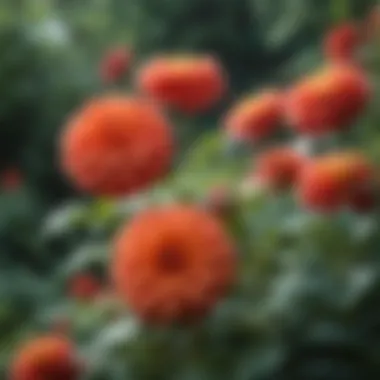

Intro
Dahlias, with their striking blooms and vast array of colors, have captivated gardeners for generations. Their beauty is not just skin deep; cultivating dahlias requires a keen understanding of their optimal conditions. Factors such as climate, soil type, and maintenance can significantly affect their growth and flowering.
In this article, we shall navigate the nuances of dahlia cultivation, shedding light on what each flower enthusiast needs to flourish in their gardening endeavors.
Key Insights and Trends
Current Climate Preferences
Climate plays a pivotal role in growing dahlias successfully. They flourish in regions where summers are warm—ideally between 70°F to 80°F. A mild winter is equally essential, as dahlias are tender perennials and can suffer in freezing temperatures. Most gardeners find that areas with sunlight for at least six to eight hours daily provide the best results. Understanding your local climate helps in choosing suitable dahlia varieties, maximizing the chances of a bountiful bloom.
Popular Soil Conditions
Dahlias prefer well-drained soil, rich in organic matter. Ideal components include peat moss, compost, and a mix of sand and loam. This combination aids in moisture retention while preventing root rot, which is often a concern for many growers. Exploring soil testing kits can further enhance your understanding. For instance, knowing the pH level can guide you in amending soil accordingly.
"The right soil and moisture balance is like a dance; it leads to the flowers performing at their best."
Gardening Techniques of the Season
current trends emphasize sustainable practices. Organic gardening, in particular, has caught on, encouraging the use of natural pesticides and fertilizers to nurture the dahlias without chemicals. Additionally, companion planting—growing complementary plants alongside dahlias—can deter pests while promoting healthy growth. Marigolds or nasturtiums, for example, can ward off harmful insects, giving dahlias a better fighting chance.
Practical Tips and How-To Guides
Step-by-Step Dahlia Planting Guide
- Select the Right Location: Choose a spot with full sun and adequate drainage.
- Prepare the Soil: Incorporate organic matter using compost or peat moss and test pH if possible.
- Planting Tubers: In spring, when the danger of frost has passed, plant dahlia tubers about 6 to 12 inches apart, burying them a few inches deep.
- Watering: Once they start sprouting, add a balanced liquid fertilizer every few weeks and maintain a regular watering schedule.
- Staking: If growing tall varieties, stake them early to avoid breakage as they grow.
- Pest Control: Regularly check for pests and remove any dead leaves to maintain good air circulation around plants.
Seasonal Care Practices
As blooms appear, it's crucial to remain vigilant. Deadheading—removing spent flowers—can encourage even more growth. Keep mulching to retain moisture and deter weeds. Come fall, remember to dig up tubers before the frost hits to ensure they survive until the next planting season. Store them in a cool, dry place over winter.
By implementing these practices, gardeners—whether novices or seasoned pros—can enjoy the mesmerizing beauty of dahlias in their gardens.
Through this comprehensive understanding of optimal conditions, growing dahlias can transform from a challenge into an exhilarating experience. As you embark on this colorful journey, remember that patience and care are your best allies in cultivating these vibrant flowers.
Understanding Dahlia Biology
In the journey of nurturing dahlias, delving into their biology yields insights that can enhance growth and blooms. Knowing how these plants operate at a cellular level opens doors to better care practices and improved flowering performance. This understanding is crucial because, at the end of the day, every gardener desires vibrant, healthy blossoms that not only please the eye but also stand the test of time.
Overview of Dahlia Species
Dahlias come in a cornucopia of varieties, each uniquely spectacular. Ranging from the compact ‘Bishop’s Children’ to towering ‘Cafe au Lait’, these species cater to diverse garden aesthetics and climatic preferences.
Notably, dahlias fall into several categories based on their flower form, such as:
- Decorative dahlias: Broad, fully filled blooms that are a sight to behold.
- Cactus dahlias: Characterized by their sharp, pointed petals adding a dramatic flair.
- Ball dahlias: Globular blooms that maintain a uniform round shape.
This variety plays a huge role in making dahlias not only delightful but also versatile for different gardeners' landscapes. Recognizing the suitable type for your area can greatly impact your success in cultivation. For instance, while dinner plate dahlias may dazzle, they may not thrive as well in regions with high winds.
Growth Patterns and Characteristics
When it comes to growth, dahlias exhibit some fascinating behaviors. During the growing season, these perennials can sprout from tubers to roots, leading to sturdy green stalks topped with exuberant flowers. Most dahlias grow about 2 to 4 feet tall, but some can stretch even higher - think of those beautiful arrangements that catch everyone’s eye!
Dahlias require certain environmental cues. For example, these plants naturally hibernate through colder months, only to spring back with vigor when temperatures rise. This pattern emphasizes their need for proper seasonal care. Knowing when to plant is as crucial as knowing how to care for them. Starting them indoors can provide an extra head start, savin' you from the frost’s chilly grip!
The flowers bloom brilliantly over summer, each petal unfurling as if unwrapping a gift just in time for those garden parties. Once established, dahlias thrive on consistent watering and nutrient-rich soil but remain sensitive to overwatering which can do more harm than good.
Understanding the particularities of dahlias also involves being aware of their vulnerability. Proper spacing helps maintain airflow, reducing the risk of fungal diseases this flower is known to suffer from. Keeping a watchful eye can go a long way in ensuring your dahlia garden turns into a vibrant paradise.
"To cultivate dahlias is to engage in a dance with nature, responding to subtle rhythms of growth, bloom, and rest."
Whether you're planning a bold garden bed or integrating these beauties into containers, knowing the specifics about their biology, growth patterns, and the range of species will set you on a path to success. The more you understand, the more rewarding your dahlia garden will be.
Climate Preferences
Understanding the climate preferences for dahlias is paramount for anyone looking to cultivate these stunning blooms. While many might view gardening as a mere pastime, the impact of climatic conditions on the growth and vitality of dahlias can’t be overstated. It's not just about planting a bulb in the ground; it’s about creating the perfect marriage between the environment and the flower.
When it comes to climate, every flower has its quirks, dahlias included. They thrive in certain temperature ranges, and their need for sunlight directly affects their color and size. If conditions aren't just right, gardeners could be left feeling both disappointed and frustrated. After all, who wants to pour time and energy into a garden only to see it wilt under unkind skies?
Benefits of nurturing dahlias in an optimal climate include not only vibrant blooms but also longer-lasting flowers and healthier plants overall. Providing the right climate can lead to an explosion of color in the garden, making the effort worthwhile.
Temperature Range
Dahlias generally prefer a temperature range between 60°F and 70°F (15°C to 21°C). Temperatures dipping below 50°F (10°C) can stunt their growth, whereas extreme heat above 85°F (29°C) can lead to stressed plants that struggle to thrive.
To put it plainly, dahlias are like Goldilocks in the garden—looking for the sweet spot that’s just right. A good practice is to monitor local weather forecasts, especially during critical growth phases. If a cold snap or heat wave is on the horizon, proactive measures like covering plants or providing shade may be needed.
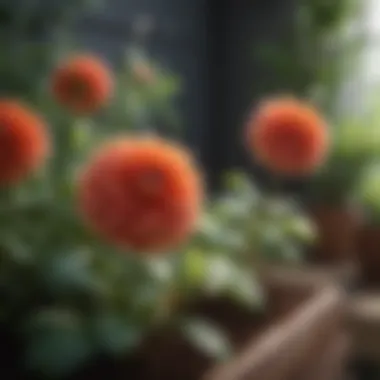
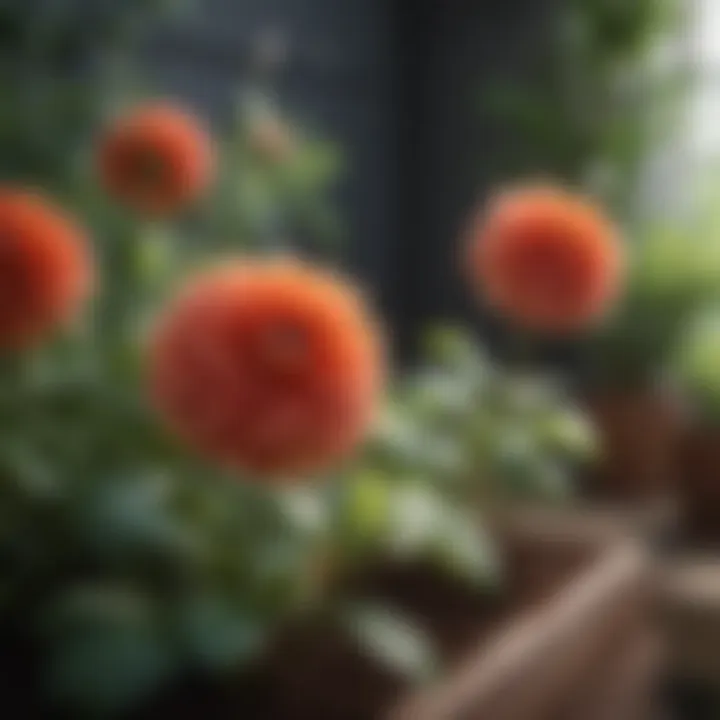
Important: Healthy dahlias will bloom into the fall if planted when temperatures are right.
Sunlight Requirements
Regarding sunlight, dahlias are sun-loving plants. They ideally need at least six hours of direct sunlight per day to promote robust growth and vibrant flowers. Gardeners should seek locations that receive full sun exposure without significant shading from trees or structures.
It's worth mentioning that while too much sun can be unkind, a shady nook will spell doom for most dahlia varieties. The output can be noticeably different based on these conditions. Blooms may appear smaller and less abundant if dahlia plants don’t soak up enough sunshine. Comparatively, excessive sunlight can lead to burnt leaves and poor flowering quality.
In summary, homeowners looking to add dahlias to their gardens should actually think of climate as the backbone of their gardening strategy. By focusing on temperature and sunlight needs, it is possible to ensure that these beautiful flowers flourish for all to admire.
Soil Composition
The foundation of successful dahlia growth hinges significantly on soil composition. Just like a house requires a sturdy base, dahlias thrive in soil that suits their unique needs. Getting this part right can make all the difference, ensuring your plants not only grow but bloom beautifully.
Ideal Soil pH Levels
Dahlias generally prefer slightly acidic to neutral soil, with a pH range of about 6.0 to 7.0. If the soil is too acidic or too alkaline, it can lead to nutrient deficiencies, ultimately affecting plant health and vigor. A simple soil test can reveal the pH levels, allowing for adjustments when necessary. If the test shows that your soil leans toward acidity, adding lime can help raise the pH. Conversely, if it is on the alkaline side, incorporating sulfur can reduce it. This fine-tuning keeps those dahlias singing in harmony with their environment.
Nutrient Requirements
When it comes to nutrients, dahlias are selective eaters. They benefit from balanced ratios of nitrogen, phosphorus, and potassium, with special emphasis on phosphorus for strong root development and vibrant blooms. A common recommendation is to use a slow-release fertilizer with an N-P-K ratio of 5-10-10. This promotes not only healthy growth but also a rich flowering period. Additionally, enriching the soil with organic matter like well-rotted compost or aged manure provides a buffet of micronutrients that support dahlia resilience against pests and diseases.
- Nitrogen: Promotes lush foliage but should be balanced to avoid excessive greenery.
- Phosphorus: Essential for root and flower development.
- Potassium: Aids in overall plant health and disease resistance.
Drainage Considerations
Another crucial aspect of soil composition is drainage. Dahlias are not fans of soggy roots. If rainwater or irrigation isn't draining well, it can lead to rot and various diseases. To ensure optimal drainage, a well-aerated soil mix is essential. Sandy or loamy mixes are ideal, maybe with a dash of perlite or grit to enhance permeability. This combination allows roots to breathe and drink without drowning, establishing a healthy growth environment.
"Healthy soil is the secret ingredient to spectacular dahlias. Without it, even the best practices fall flat."
In summary, the soil composition for dahlias needs careful attention. Focus on maintaining the right pH, providing adequate nutrients, and ensuring proper drainage. By doing so, you set the stage for those dahlias to thrive, showcasing their brilliance.
Selecting Planting Site
Choosing the right planting site is crucial for the health and vibrancy of your dahlia plants. This decision carries weight, as the location not only dictates the sunlight their delicate petals will soak in but also influences temperature variations and wind exposure. A well-considered site ensures dahlias can thrive, showcasing their brilliant colors while resisting pests and diseases.
Evaluating Garden Layout
When thinking about your garden layout, consider the sun's journey throughout the day. Dahlias bask in full sunlight, typically requiring at least six to eight hours of direct sun. If your garden has shaded nooks from trees or structures, it's paramount to steer clear of these spots for planting. Position your dahlias toward the southern quadrant where they can soak up the rays.
Another consideration is the spacing between your plants. As these beauties grow, they can take up space, so give them room to breathe by spacing them out adequately. This encourages airflow, which can prevent fungal infections. A little extra space goes a long way in keeping your garden healthy.
"The right spot can be the difference between a splendid display and a garden gone awry."
Microclimate Identification
Microclimates refer to small areas within your garden where conditions differ from the surrounding environment. Identifying these can make a world of difference for your dahlias. For example, if your garden has a steep slope, the sunny side receives plenty of warmth, making it a prime candidate for growing dahlias. On the flip side, the shaded side may stay cooler and damp, not ideal for these sun-loving flowers.
Additionally, consider windbreaks—natural barriers like fences or shrubs can shield delicate dahlias from harsh winds which may damage the flowers or foliage. If your property has spots that capture warmth during the day, these can become cozy homes for your dahlias, allowing them to flourish even as nighttime temperatures drop.
Watering Techniques
Watering is a crucial part of cultivating dahlias, as it directly influences their growth, flowering, and overall health. Getting this aspect right can mean the difference between lush blooms and lackluster plants. Dahlias thrive when their watering needs are met, making it essential for gardeners to understand how and when to give these blossoms the moisture they crave. In this section, we’ll dive into how to ascertain dahlia’s watering needs and discuss effective irrigation methods.
Understanding Watering Needs
When it comes to watering dahlias, timing and quantity are everything. These plants require consistent moisture, but they aren’t fond of sitting in waterlogged soil—this can lead to root rot.
- Frequency: On average, dahlias need about an inch of water per week. During hot, dry spells, they might require more frequent watering. Pay attention to the soil—if the top inch feels dry, it’s time to hydrate them.
- Soil Type: The kind of soil you’re working with will affect how often you water. Sandy soils drain quickly, meaning they require more regular watering compared to clay soils, which hold moisture for longer periods.
- Stage of Growth: Young dahlias need a bit more water than established ones, especially during their initial growth phase. A small adjustment in watering can create stronger roots and a more vibrant bloom later on.
- Environmental Factors: Pay heed to the weather; warm, windy days can evaporate moisture faster than chillier or overcast periods. Keep an eye out for signs of stress in your plants, like drooping leaves, which might indicate a thirsty dahlia.
"Watering techniques are not just about pouring liquid on the roots. It’s an art that requires attention and adaptation."
Irrigation Methods
Selecting the right irrigation method for your dahlias can significantly impact their moisture levels and overall growth. Here are a few tried and true strategies:
- Soaker Hoses: These are a gardener's best friend. Soaker hoses can be laid out along the rows of dahlias and will deliver moisture directly to the soil over time. This method minimizes evaporation and ensures consistent watering.
- Drip Irrigation: Ideal for those with a larger garden, drip irrigation systems can be set up to deliver designated amounts of water right at the root zone where it's needed the most. This keeps the surface dry and reduces the risk of fungal issues.
- Hand Watering: For small gardens or individual plants, nothing beats the old-fashioned watering can or hose. Use a gentle spray to avoid displacing delicate soil and damaging tender roots.
- Mulching: While not a watering method per se, applying a layer of mulch can help retain moisture and regulate soil temperature. It reduces the frequency of watering while also providing some nutrient benefits as it breaks down.
Fertilization Strategies
Fertilization is a cornerstone in the successful cultivation of dahlias. Like any plant, dahlias require a balanced supply of nutrients to thrive, grow tall and produce vibrant blooms. When considering fertilization strategies, it’s crucial to note that different growth stages demand varied nutrient compositions. Proper fertilization not only boosts growth but also enhances the flower's color and size, leading to a more striking display in gardens. Understanding how to implement effective fertilizer methods can help any dahlia enthusiast achieve truly stunning results.
Types of Fertilizers
Selecting the right type of fertilizer can feel like walking a tightrope. It’s a balance of providing adequate nutrients without overwhelming the plants. Here’s a closer look at the most commonly used fertilizers for dahlias:
- Granular Fertilizers: Generally easy to use, they release nutrients slowly over time. Look for those rich in potassium and phosphorus, which support flower development. A popular choice among gardeners is the 10-20-20 formulation.
- Liquid Fertilizers: These offer a quick nutrient boost and are perfect for spreading around especially when dahlias are showing signs of stress or insufficient growth. They require more frequent application but can quickly improve the health of the plants.
- Organic Fertilizers: Using compost or well-rotted manure can enrich the soil with microbial life and long-lasting nutrients. Though slower to act, organic options help ensure the soil remains healthy over time, making it a sustainable choice for dedicated gardeners.
- Slow-Release Fertilizers: These can be a game-changer for busy gardeners. They gradually release nutrients over several months, providing a steady supply without constant monitoring.
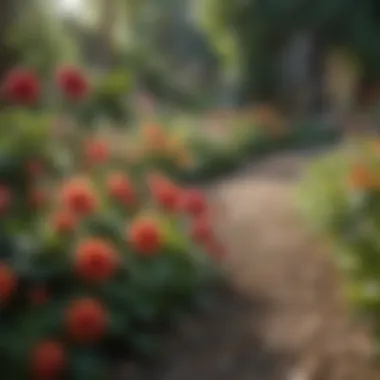

When deciding on a fertilizer, always check the ratios of nitrogen, phosphorus, and potassium and remember that dahlias favor a mix with higher phosphorus for vibrant blooms.
Application Timing
Timing is everything in gardening, and for dahlias, it’s no different. Knowing when to apply fertilizer can significantly affect their growth. Here are some general guidelines to consider:
- Pre-Planting: Before planting the tubers, it’s beneficial to amend the soil with compost or a slow-release fertilizer. This foundational step ensures that the soil is nutrient-rich from the get-go.
- Growing Season: Once dahlias start to sprout leaves, feed them with a balanced fertilizer every four to six weeks. Monitoring the plants for signs that they may need extra nutrients—like pale leaves—will help you adjust your routine.
- During Blooming: When flower buds begin to form, switching to a fertilizer with a higher phosphorus content can encourage more blooms. Just be careful not to overdo it. Too much can cause the plants to focus on leaf growth instead of flowers.
A rule of thumb is to ease off the fertilization as the blooms begin to fade in late summer. This allows the plant to transition into dormancy naturally, making it easier for the tubers to store energy for the next blooming cycle.
"Proper fertilization strategies not only support healthy plant growth but unlock the potential for stunning flower displays."
By understanding the nuances of fertilizer types and application timing, any gardener can create an optimized environment for their dahlias. This foundation in fertilization sets the stage for flourishing dahlias that draw admiration, making your garden a vibrant showcase of beauty.
Pest and Disease Management
Pest and disease management is a crucial aspect of cultivating dahlias. Failing to adequately address these concerns can lead to stunted growth or even the loss of entire plants. Understanding the specific threats to dahlias and implementing preventive measures allows gardeners to ensure lush blooms and a thriving garden. Moreover, a proactive approach can save time and money in the long run, not to mention safeguarding the fragile beauty of these flowers. This section delves into the common pests that can afflict dahlias and explores effective disease prevention techniques to keep your plants healthy.
Common Pests Affecting Dahlias
When it comes to dahlias, certain pests have a habit of showing up uninvited, and knowing how to spot them can save a lot of heartache.
- Aphids: These small insects gather on the tender shoots and the undersides of leaves, sucking away sap and weakening the plant. They can also spread diseases, which makes them especially problematic.
- Spider Mites: Almost invisible to the naked eye, these pests thrive in hot, dry weather. They create fine webbing and can cause leaves to yellow and die if not controlled promptly.
- Slugs and Snails: On a rainy day, these slimy creatures can munch on dahlia leaves and flowers, causing round holes that mar their beauty.
- Cutworms: These larvae are notorious for their underground feeding habits, where they can sever young plants at the base, leading to sudden plant loss.
To keep these pests in check, regularly inspect your dahlias, looking under leaves and around the soil. Utilizing beneficial insects, such as ladybugs, can also help manage these populations organically.
Disease Prevention Techniques
Preventing diseases is often more effective than attempting to cure them after the fact. A few strategies can help maintain the health of your dahlias:
- Good Air Circulation: Proper spacing between plants allows air to flow freely, reducing humidity and the risk of fungal diseases.
- Soil Health: Healthy soil promotes strong plants that are less susceptible to diseases. Amending your soil with organic compost enriches it and supports beneficial organisms that help resist disease.
- Watering Practices: Avoid overhead watering, which can promote fungal growth. Instead, aim to water at the base of the plants early in the day, allowing any excess moisture to evaporate.
- Crop Rotation: Avoid planting dahlias in the same spot year after year, as this can lead to soil-borne diseases building up over time. Rotate with other plant types to break this cycle.
"An ounce of prevention is worth a pound of cure."
Incorporating these practices into your gardening routine not only protects your dahlias from pests and diseases but can create a more vibrant floral display. Gardening should be a joyful experience, and by being vigilant about pest and disease management, you can enjoy the fruits of your labor with fewer headaches.
Seasonal Care Practices
In the journey of cultivating dahlias, seasonal care practices play a pivotal role. It’s like the heartbeat of a garden, keeping everything alive and thriving through the ever-changing seasons. From ensuring healthy growth during spring to prepping for the chilly embrace of fall, these seasonal tasks are a guide to truly making the most of your dahlia garden. Seasonal care isn't just about keeping the plants alive; it's about fostering an environment where they can flourish and display their stunning blooms.
Spring Preparation
Spring signals the start of a new growth cycle, and it’s when the lookout for dahlias intensifies. A successful spring prep sets the stage for vibrant flowers all summer long. Check soil for looseness; it’s like giving your plants a cozy bed to rest in. This is also the time to inspect dahlia tubers for any signs of rot.
- Soil Amendment: Before planting, work compost or a balanced fertilizer into the soil. Nutrient-rich soil promotes strong root systems.
- Proper Planting Depth: When introducing the tubers into the ground, keep in mind that they prefer a depth of about 4-6 inches. This gives them room to grow and a fighting chance against the summer heat.
- Watering: After tubers are planted, water well but avoid drowning them. Consistency here is key. It’s like giving them a gentle nudge rather than a full-blown splash.
Taking these steps not only aids in establishing healthy growth but also makes room for robust flowering through the summer months.
Summer Maintenance
Once the dahlias are up and running, summer maintenance is your game plan. During this period, keeping an eye on them means everything. Monitoring moisture levels and watching for pests is akin to a parent ensuring their child is eating right. Don’t forget, dahlias need to be fed regularly to sustain their blooming potential.
- Regular Watering: As the heat cranks up, dahlias usually need more water. Aim for at least an inch of water per week. Pay attention to the weather; during particularly hot spells, you may need to increase watering frequency.
- Staking Plants: Tall varieties benefit from staking as they flourish. Use stakes early to avoid damaging the stems later.
- Deadheading: Remove spent blooms to encourage new flowers. This practice keeps your dahlias looking fresh and vibrant, giving them that extra oomph.
Taking these steps can prevent common issues and keep your dahlias blooming bright.
Fall Harvesting and Storage
When fall rolls around, it’s time for harvesting dahlias, which brings a mix of excitement and sadness. You’ve invested time, care, and effort into these plants, and it’s essential to do this right. Proper harvesting signals the end of one growing season and the preparation for the next. Your dahlias deserve a dignified exit.
- Timely Harvest: Don’t leave tubers in the ground when frost threatens; it’s like leaving a wool sweater out in the rain. Dig them up when the leaves start to yellow and before frost sets in.
- Curing Tubers: Once harvested, allow tubers to dry in a shaded, well-ventilated area for a few days. This helps prevent rot during storage.
- Ideal Storage Conditions: Store tubers in peat moss or vermiculite in a cool, dark place with temperatures around 40-50°F. Avoid moisture as stored tubers should be kept dry.
Proper fall practices are a vital aspect of dahlia cultivation. The way they are handled post-harvest lays the groundwork for brilliant blossoms in the following year.
"The secret of gardening is to make a friend of the seasons. Each has its gifts and challenges."
In summary, seasonal care practices are essential not only for maintaining health but also for fostering the beauty of dahlias through diligent attention and affection. Being proactive through the spring, intentional in the summer, and careful in the fall creates a cycle of growth and renewal, one season building upon the last.
Innovative Cultivation Techniques
In the ever-evolving world of gardening, adopting innovative cultivation techniques can make all the difference when it comes to growing dahlias. These methods not only enhance the aesthetics of the garden but also optimize space, simplify care, and increase the overall health of the plants. Understanding and implementing such techniques allows both amateurs and experienced gardeners to experiment with their crafting skills while still focusing on productivity. Here, we will delve into two significant approaches that have been gaining traction: container gardening and vertical gardening.
Container Gardening for Dahlias
Container gardening offers a unique solution for those who have limited space or wish to add a splash of color on patios or balconies. Cultivating dahlias in pots not only elevates these vibrant flowers but also provides flexibility in their placement.
- Benefits:
- Considerations:
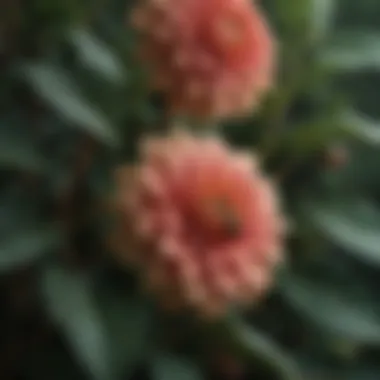
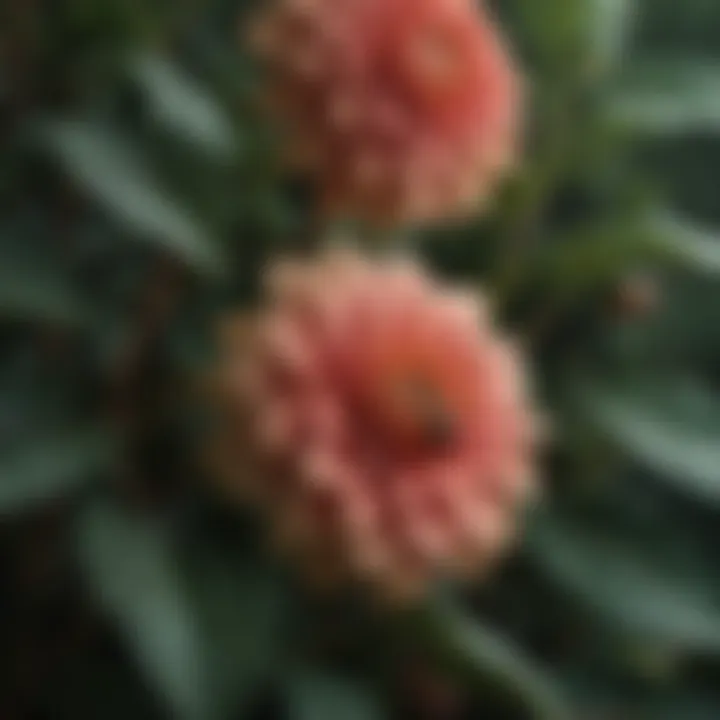
- Mobility: You can move your pots around to catch the ideal sunlight, shielding them from harsh weather when needed.
- Soil Control: This method allows for better control over soil quality, drainage, and nutrition.
- Pest Management: Keeping dahlias in pots can minimize pest infestations, as insects may find it harder to access the plants efficiently.
- Choose solid, well-drained pots with a width of at least 12 inches for sufficient root space.
- Use high-quality potting mix specifically designed for flowering plants.
- Regular watering is critical, as container plants may dry out faster than those planted in the ground.
When done correctly, container gardening provides an ideal opportunity to showcase different varieties of dahlias and create dynamic arrangements that draw the eye.
Vertical Gardening Applications
Vertical gardening is another innovative approach that optimizes space utilization while introducing a fresh aesthetic element. This technique is particularly useful for smaller gardens or urban settings where horizontal space is at a premium.
- Benefits:
- Considerations:
- Space Saving: By training dahlias to grow upwards, you utilize vertical space, freeing up ground space for other plants.
- Air Circulation: Vertical arrangement enhances air circulation around the plants, reducing the risk of diseases related to moisture buildup.
- Visual Appeal: A vertical display can create striking visual lines, adding depth and dimension to your garden.
- Use sturdy trellises or walls to support the growing dahlias effectively.
- Ensure that the dahlias receive the appropriate amount of sunlight, as those higher up might receive more intense light.
- Regularly check for potential damage as the plants grow, as heavy blooms can sometimes lead to bending or breaking.
"Innovative gardening techniques, such as container and vertical gardening, enable gardeners to push the boundaries of traditional methods while still aiming for a remarkable aesthetic."
Both container gardening and vertical gardening offer powerful methods for enhancing your dahlia-growing experience. By embracing these innovative techniques, gardeners can tackle space limitations and encourage healthier, more robust plants, enriching their gardening journey and achieving stunning results.
Dahlia Varieties to Consider
Choosing the right dahlia variety can remarkably influence garden aesthetics and even the ease of cultivation. With countless classifications available, understanding what suits your specific environment and personal taste is essential. Selecting the perfect dahlia isn't just a matter of preference; it is also pivotal for ensuring that the plant thrives under your care. By exploring various varieties, you can create visually stunning displays while catering to your gardening conditions.
Classification by Size
Dahlias come in various sizes, which can impact your design choices and cultivation strategy. The size categories primarily include:
- Dwarf Dahlias: Typically topped around 12 to 18 inches, these petite flowers fit nicely in smaller gardens or containers, making them perfect for patios or balcony design.
- Medium Dahlias: Ranging from 2 to 4 feet tall, medium-sized dahlias offer a balance, bringing presence without overwhelming a space. They're excellent for mid-border plantings.
- Giant Dahlias: These striking flowers can grow to over 4 feet tall and need ample space to flourish. Their grandeur makes them show-stoppers in any garden layout but may demand some sturdier support due to their height.
When selecting for size, consider not only the space you have but also how each variety complements other plants in your garden. For example, mix in some dwarf varieties with medium ones to create depth in your garden borders.
Color Variations
Dahlias boast a breathtaking array of colors, making them a favorite among gardeners. Their pigments range from bold reds to soft pastels, and many varieties exhibit multiple hues within a single flower. This color diversity allows for creative expression in your garden design. Some of the popular categories include:
- Solid Colors: Varieties like the ‘Red Skin’ or ‘Black Satin’ offer vibrant, single-tone blooms that can stand out dramatically against lush green backgrounds.
- Bi-Color Varieties: Flowers like ‘Café au Lait’ present an interplay of colors, often blending soft shades for a more intricate look. This type can add depth and interest to sections of your garden.
- Patterned Dahlias: Such varieties include the popular ‘Frizzy Lizzie,’ which features charming bursts of color that draw the eye and spark conversations among visitors.
In considering color, one must think about seasonal changes and how different hues will harmonize or contrast with the rest of the garden. A well-planned dahlia display can transition beautifully across the seasons, often becoming the focal point of your yard.
"The beauty of dahlias is not just in their colors but in how they can transform an ordinary garden into a canvas of floral art."
Cultural Significance of Dahlias
Dahlias carry a richness that goes beyond their visual allure; they are steeped in history and laden with meaning. In the world of horticulture and beyond, the cultural significance of dahlias illustrates not only their aesthetic appeal but also their symbolic depth. In this article, we delve into how dahlias have become more than mere garden flowers by exploring their historical context and the rich tapestry of symbolism they embody across diverse cultures.
Historical Context
Dahlias were first discovered by Spanish explorers in the late 18th century in Mexico, where they flourished in vibrant colors and impressive forms. Originally, their roots were edible, utilized by indigenous peoples for food. However, it was their unique beauty that captivated horticulturists, leading to their eventual importation back to Europe.
By the early 1800s, dahlias were celebrated in British gardens, and hybridization began to change their appearance and variety dramatically. This period marked a renaissance in gardening where dahlias became a symbol of horticultural achievement. Their varied color palettes and complex bloom structures heralded a new era, capturing the admiration of plant enthusiasts. The Royal Horticultural Society, established in England, also played a significant role in promoting dahlias, encouraging their cultivation through competitions and exhibitions.
Through the ages, dahlias have graced significant cultural events, from royal gardens to botanical exhibitions. The flower's adaptability has contributed to its widespread acceptance, which transcends class and region. Their enduring presence in gardens signifies a nod to the dedication of generations of gardeners who have nurtured and hybridized them into the beloved blooms we cherish today.
Symbolism in Different Cultures
Across numerous cultures, dahlias wear different symbolic hats, representing everything from elegance to commitment. In the Victorian era, flowers served as a language of their own, with dahlias signifying dignity and inner strength. People would craft intricate bouquets to convey messages; the presence of dahlias indicated a complex emotion and a sense of nobility.
In Mexico, dahlias have a special place in customs and festivities. The state of Oaxaca holds an annual festival celebrating the dahlia, honoring not just the flower itself but also the artistry involved in its cultivation. This reflects a broader cultural reverence for flora and the connections it fosters within communities.
In a broader spiritual context, dahlias are often seen as symbols of change and personal growth. Each bloom represents a transformative journey, encouraging individuals to embrace inner strength. This view has resonated in personal gifting; a dahlia, when given, is often a wish for hope and resilience.
Moreover, in recent years, dahlias have resurfaced as icons in popular culture, turning up in art and design trends. Their variety and dynamism resonate with modern aesthetics, capturing the eye of interior designers and party planners alike. The interplay between dare and beauty makes them a frequent choice for arrangements in events, reflecting creativity and individuality.
"A flower does not think of competing with the flower next to it. It just blooms."
- Zen Shin
Finale and Future Trends
The benefits derived from a thorough understanding of dahlias extend beyond just aesthetics. Growing these flowers can foster community engagement, support biodiversity, and even contribute to mental well-being. Hence, it is vital for both amateur and seasoned gardeners to stay informed about evolving techniques and ideas that lead to healthier and more productive blooms.
Summarizing Key Takeaways
- Knowledge is Power: Understanding the biology, growth patterns, and specific needs of dahlias is crucial in their cultivation.
- Climate Matters: Dahlias thrive best in certain temperature ranges and sunlight conditions, which should be carefully considered when planning a garden.
- Soil Composition: Optimal pH levels and nutrient content greatly influence the health of dahlias. Regular testing and amendment of soil can yield remarkable results.
- Watering and Care: Adequate watering techniques, schedules, and seasonal care practices, such as proper fertilization and pest management, contribute directly to the vigor of dahlias.
- Continuous Learning: Gardening is an evolving practice; staying updated on innovative cultivation techniques is essential for all gardening aficionados.
Exploring Future Cultivation Innovations
As we look ahead, the world of dahlia cultivation is ripe for innovation. There are several exciting trends and techniques that gardeners may want to explore:
- Hydroponic Growing: Increasing interest in hydroponic systems shows that growing dahlias without soil is becoming more feasible. These systems can yield more abundant blooms in shorter times, as water and nutrients are delivered directly to the plants’ roots.
- Smart Gardening Technologies: Utilizing IoT devices for monitoring soil moisture, temperature, and nutrient levels could drastically enhance care and yield of dahlias. Smart pots and apps simplify tracking grow conditions.
- Sustainable Practices: Movements toward organic gardening and permaculture continue to inspire gardeners to adopt more environmentally friendly methods. The focus on native plants and pollinator-friendly gardening ensures dahlias can coexist beneficially with local ecosystems.
- Breeding for Resilience: Genetic research could lead to the development of new dahlia varieties that are more resistant to pests and diseases, thriving despite fluctuations in weather.
Adapting to these innovations will not only streamline the process of growing dahlias but also raise the satisfaction levels among gardeners as they witness their blooms flourish against the backdrop of modern agriculture practices. As we embrace a future of gardening that prioritizes technology and sustainability, the dahlia will likely hold its position as a beloved staple in gardens.



